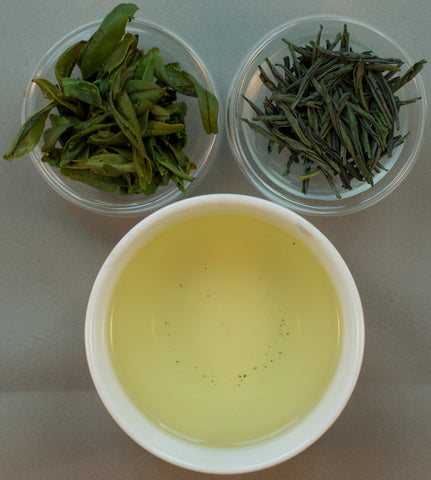This Bao Hong green tea is just the kind of tea that gets me excited in this world of generic, commodity teas. It’s delicious, it has history, and it is cultivated and made with dedication and love. I’m still trying to sleuth out the name of the cultivar, if it has one, but the original plant is believed to have been brought to Bao Hong Mountain by a wandering monk from Fujian. Cultivation started during the Tang Dynasty (A.D. 618-907) around the same time as the Bao Hong Si Buddhist Monastery was being built on the mountain and has continued ever since. The Liu Family has been growing this tea for at least 10 generations.
This tea is similar to Long Jing/Dragonwell is many respects. It has a unique history and provenance, a similar appearance in the dry and steeped leaf, and in its taste. Yet it is unique in its own right and a great value given the skyrocketing price of authentic Long Jing.
Provenance:
-
Origin: Bao Hong Mountain, Yi Liang County, Yunnan Province, China
-
Grower/Teamaster: Liu Family
-
Elevation: 1550-1630m
-
Harvest Date: March 2023
-
Cultivar: Still researching; from a Fujian varietal
-
Cultivation: Natural cultivation in a remote un-adulterated environment
-
Plucking Standard: Fine Picking; bud & two leaves
-
Processing Notes: leaves picked in a two hour early morning window
-
Nickname: Bao Hong
-
History/Pedigree: Cultivation started during the Tang Dynasty (A.D. 618-907). The Liu Family has been growing this tea for at least 10 generations.
Brewing Suggestions1:
-
Water: 170-180˚F
-
Tea: 2g per 4oz of water (about a level 2 tsp2)
-
Infusion: 2 minutes for 2-3 infusions or until tea is steeped out
Tasting Notes:
- The leaves brew up full and plump for their small size, with the downy hair from the leaves floating in the liquor. Fragrant with grassy and mineral notes coming through especially on the second infusion.
1 Brewing suggestions are just that. Try it the suggested way then experiment. In this case I suggest experimenting with an “Eastern” style infusion: double the quantity of tea per oz of water and do short infusions of 5 sec, 10 sec, 15 sec, 30 sec, 45 sec, and then 1 minute infusions until the tea is steeped out. I usually use a much smaller infusion vessel for this style, maybe 2-4oz as I am going to get so many infusions out of the tea. You can also experiment with temperature as the tea can handle hotter water with the short infusion times. Some tea drinkers like to use slightly hotter and longer times for each subsequent infusion.
2 Weighing your tea is always the best way to control your dosage. I provide approximate volume measures for convenience but they can be problematic due to the variance in tea leaf shape and size. It’s best to use the single appropriate volume measure for the tea, i.e., don’t try to measure 1.5TB using two spoons meant to measure 1 TB and a ½ TB. Use an actual 1.5 TB measuring spoon. Yes, they make them! I like the oblong ones to handle longer leaf styles.



